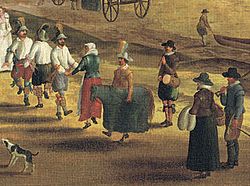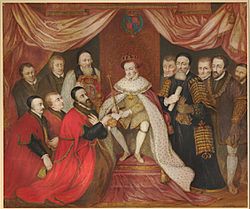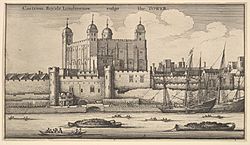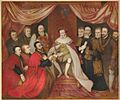George Barne (died 1558) facts for kids
Quick facts for kids
Sir George Barne
|
|
|---|---|
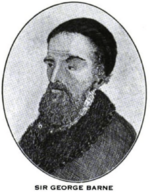 |
|
| Lord Mayor of London | |
| In office 1552–1553 |
|
| Preceded by | Richard Dobbes |
| Succeeded by | Thomas Whyte |
| Sheriff of London | |
| In office 1545–1546 |
|
| Personal details | |
| Born | about 1500 |
| Died | 18 February 1558 |
| Occupation | merchant |
Sir George Barne (died 1558) was an English businessman who lived in London. He was very important in starting new trade routes for England. These routes went to places like Russia, West Africa, and North America, which were far from where English merchants usually traded.
In 1553, he became a knight. He also served as a Sheriff of London and later as the Lord Mayor of London. Sir George Barne was the father of Sir George Barne (died 1593) and the grandfather of Sir William Barne.
Contents
Early Life and Business Beginnings
George Barne's father was also named George Barne. Their family had connections to Wells, Somerset. His father was a member of the Worshipful Company of Haberdashers, which was a powerful group of merchants in London.
George Barne joined the Haberdashers' Company too. He married Alice Brooke from Shropshire. His oldest son, George, was born around 1532. Barne continued his family's traditional trading business. He would export cloth from England and import wine from places like Spain. He became more and more successful in the Haberdashers' Company.
Becoming a Sheriff: 1545-1546
By 1542, Barne had become very successful in London's public life. He was chosen as an alderman for the area called Portsoken. Less than three years later, in 1545, he became a Sheriff of London. He served alongside Ralph Aleyn. This was during the time Sir Martin Bowes was the Lord Mayor. Their term as Sheriff was the last full one before King Henry VIII died in January 1547.
During this year, there were big celebrations for a peace treaty called the Treaty of Ardres. There was also a huge Midsummer Watch parade through London led by the Lord Mayor. As Sheriff, Barne had duties related to law and order. In 1546, he changed his alderman role from Portsoken to Coleman Street, where he stayed until 1558.
New Opportunities for Trade
During the middle years of King Edward VI's rule, Barne became very important in starting new voyages to expand England's trade overseas. At this time, the Hanseatic League, a group of German merchants, was losing its power. This allowed English traders to explore new opportunities.
English contact with North America and Newfoundland had started in 1497 with John Cabot's voyages. His son, the explorer Sebastian Cabot, wanted to find a sea route to Cathay (China) by going through the Northwest Passage.
In 1550-1551, Sebastian Cabot helped King Edward with some trade disagreements. In December 1551, Cabot, along with Sir Hugh Willoughby and Richard Chancellor, and some important London citizens, formed a new company. It was called the "Company of Merchant Adventurers for the Discovery of Regions, Dominions, Islands, and Places unknown." This company later became known as the "Muscovy Company." King Edward wanted to give them an official charter, but he died before it could be signed.
George Barne and William Garrard were key people in starting the company's first big expedition in 1553. This journey led to Willoughby discovering Novaya Zemlya. Sadly, Willoughby and his crew were lost while looking for the Northeast Passage to China. However, Richard Chancellor successfully traveled from the Northern Dvina river to Moscow. There, he met and negotiated with Tsar Ivan IV.
Serving as Lord Mayor: 1552-1553
Sir George Barne was elected as the new Lord Mayor on September 29, 1552. His time as Mayor was full of dramatic events. He managed to keep the City of London safe and calm through it all. His Sheriffs during this time were John Maynard and William Garrard.
Fun and Pageants
During Christmas 1552, King Edward had a "Lord of Misrule" named George Ferrers. This was a person chosen to lead festive fun and games. On January 4, 1553, the King's Lord of Misrule came to Tower Wharf with his group. They met the Sheriff's Lord of Misrule. Both groups were dressed in fancy velvet suits and embroidered costumes with ribbons and sparkles. They had horse riders, jesters, and morris dancers. They paraded through London, making announcements with their heralds.
At a special platform, the King's lord knighted the Sheriff's lord. They drank to each other, and gold and silver coins were thrown to the crowd. The two lords of misrule then went to dine with the Mayor and later visited the Sheriff's house. They continued their parade through the city until evening.
Helping the City's People
On November 21, 1552, poor children from the City were taken into Christ's Hospital. Other sick and poor people were taken into St Thomas' Hospital in Southwark. They received lodging, food, drink, and clothes from the City's charity. On Christmas Day, when the Lord Mayor and aldermen rode to St Paul's, about 350 children from the hospitals, dressed in their uniforms, lined the street.
Barne also worked to improve trading standards. He punished people who cheated their customers. He also had people who sold goods with false measurements put in the pillory. He made sure that people who caused trouble were removed from the city. Because he was fair and firm in his decisions, many people respected him.
In April 1553, King Edward gave his official permission for the Bridewell Palace to be used by the City. It became a hospital for poor children and a place to help women who needed guidance. A famous picture shows Sir George Barne, as Mayor, receiving this important document for the City.
The Willoughby Expedition Begins
Barne was knighted by the King on April 11, 1553. On that day, the King traveled by water from Westminster to Greenwich. Along the way, ships fired their cannons to salute him. At Ratcliff, three ships and two smaller boats were getting ready to sail to the "New-fouland" (likely meaning new lands). These ships were the Edward Bonaventure, the Bona Esperanza, and the Bona Confidentia. They were preparing for an expedition to find a sea route to Far Cathay (China) or at least to northern Russia. This journey was led by Sir Hugh Willoughby and Stephen Borough, with the navigator Richard Chancellor.
This was the start of a huge project, a dream of Sebastian Cabot. Many important people and merchants invested their money to support this voyage. The company that promoted this trip was meant to receive an official charter from King Edward. However, the King died before the charter could be fully signed.
Despite this, the three ships set sail from Deptford on May 10, 1553. The company, commonly known as the Muscovy Company, later received a charter from Queen Mary in 1555. Sir George Barne was named as one of the four main leaders, called Consuls, for the company.
Changes in Power: Queen Jane and Queen Mary
The young King Edward VI died on July 6, 1553. Two days later, the Lord Mayor was called to a secret meeting. The Duke of Northumberland told them the news. He asked them to sign a document that would make Lady Jane Grey the new queen. This was done to prevent King Edward's Catholic sister, Mary, from taking the throne.
Lady Jane Grey was brought to the Tower of London and was announced as queen on July 10, 1553. Sheriff William Garrard proclaimed her queen in London. However, many people supported Mary, and she was proclaimed the rightful queen in other parts of England. The Duke of Northumberland went to stop Mary, taking many lords and soldiers with him.
Soon, it became clear that Mary would become queen. The City of London quickly changed its support to Mary. This quick change likely saved the City from more trouble.
Welcoming Queen Mary
On July 19, 1553, Sir George Barne had a secret meeting with important leaders. They told him that they must ride to Cheapside to announce Queen Mary as the new ruler. When they arrived, a herald announced the proclamation to a very happy crowd.
The Mayor and the leaders then went to St Paul's Cathedral and sang a song of praise. Bells rang in every church, and bonfires were lit in the streets. People set out tables for banquets. As the Queen was escorted around the city, people cheered, "God save Queen Mary!" The next day, many important leaders dined at the Lord Mayor's house. This is how Queen Mary gained control of London and secured her place as queen.
On August 3, 1553, Queen Mary officially entered the City of London. She rode on a horse, dressed in her royal clothes, with many lords, knights, ladies, and gentlemen. At Aldgate, the Lord Mayor, Sir George Barne, knelt and offered her the scepter of his office. He welcomed her to her City of London. Sir George Barne kissed the scepter and gave it to the queen. She smiled and thanked him and the aldermen, saying she knew they had always been good to her. Then, she gave the scepter back to him, showing she accepted his loyalty.
The streets were decorated with rich cloths, and members of all the City's companies lined the way. There were stages with musicians. The Lord Mayor, carrying his scepter, rode before the queen as she went to the Tower of London. Children from Christ's Hospital also gave a speech. The Lord Mayor left as Queen Mary entered the Tower.
After this, some of the people who had supported Lady Jane Grey were arrested. On August 22, the Duke of Northumberland and others were executed.
Expanding Trade to Russia and Guinea
Sir George Barne helped to pay for the first English voyage to Guinea (in West Africa) in 1553. This trip was led by Thomas Wyndham. When the Company of Merchant Adventurers for Trade with Unknown Lands received its official charter from Queen Mary in 1555, Barne was named as one of the four main leaders. He continued to be a strong supporter of increasing trade with Russia.
Death and Lasting Impact
Sir George Barne died on February 18, 1558. He had a large public funeral on February 24 at the church of St Bartholomew-by-the-Exchange. Because he was the most important merchant in the Muscovy Company at the time, a flag with the company's symbols was carried in his funeral procession. Eighty poor men wore black gowns, and the Lord Mayor and his sword-bearer also wore black.
His wife, Dame Alice Barne, died in 1559. She was buried next to her husband. She also had a public funeral, with twenty singers and many people attending.
Family Legacy
Sir George Barne and Alice Brooke had several children:
- Sir George Barne (died 1593) married Anne Garrard.
- John Barne married Jane Langton.
- Elizabeth Barne married Sir John Rivers, who became Lord Mayor of London in 1574.
- Anne Barne married Alexander Carleill, and later Sir Francis Walsingham.
His son, George, continued many of his father's trading businesses. The Barne family later became connected with Sotterley Hall in Suffolk.
Images for kids
-
A hobby horse with morris dancers at Richmond, London (painting, c. 1620)


